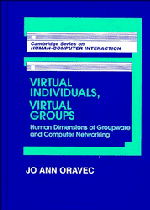Book contents
- Frontmatter
- Contents
- Dedication
- Overview
- Introduction
- 1 Evolution of computer application genres: Groupware and other network-based system applications
- 2 On the infinite variety of virtual entities
- 3 The shape of groups to come: Efforts to define, label, explain, and model collaborative activity
- 4 Shared resources and spaces: Lessons from the use of desks, tables, whiteboards, office settings, and video
- 5 Cultural objects and technological dreams: Dependence, autonomy, and intellectual augmentation
- 6 Privacy, anonymity, and agency: Applications of computer networking and the development of social analogues
- 7 Toward a genre-responsive design approach for computing applications
- Bibliography
- Author index
- Subject index
2 - On the infinite variety of virtual entities
Published online by Cambridge University Press: 05 August 2011
- Frontmatter
- Contents
- Dedication
- Overview
- Introduction
- 1 Evolution of computer application genres: Groupware and other network-based system applications
- 2 On the infinite variety of virtual entities
- 3 The shape of groups to come: Efforts to define, label, explain, and model collaborative activity
- 4 Shared resources and spaces: Lessons from the use of desks, tables, whiteboards, office settings, and video
- 5 Cultural objects and technological dreams: Dependence, autonomy, and intellectual augmentation
- 6 Privacy, anonymity, and agency: Applications of computer networking and the development of social analogues
- 7 Toward a genre-responsive design approach for computing applications
- Bibliography
- Author index
- Subject index
Summary
Let us hope … that in the years ahead we can construct a society that is less in need of suffering and a self that is less a sacrifice to the nihilistic economics and politics of our time.
Philip Cushman (1990, pp. 608–609)This book is about virtual individuals and virtual groups. It is also about a specific set of computer system applications – groupware and other network-based systems – and the way we employ them in construction, dissemination, and manipulation of these virtual entities. To an increasing extent, management in organizational contexts has become the management of virtual individuals and groups. These virtual entities are employed in establishing the patterns and setting the standards by which we are evaluated and with which we often must conform.
Virtuality has become a common theme in American life, taking on connotations of the “imaginary,” as well as the “designed” or “engineered”: “virtual corporations” are created when corporations design sets of linkages with each other and with critical environmental factors, thus extending their effective spheres of influence (Davidow and Malone, 1992). Instead of tales about lonely teens and their imaginary companions, stories about an engineered “virtual girl” are consumed in the mass market (Thomson, 1993).
A virtual individual is a selection or compilation of various traces, records, imprints, photographs, profiles, and statistical information that pertain (or could reasonably be said to pertain) to an individual – along with writing done, images produced, sounds associated with, and impressions managed by the individual. The amalgam that results (whatever its components) is associated with the individual in the context of particular genres and artifacts.
- Type
- Chapter
- Information
- Virtual Individuals, Virtual GroupsHuman Dimensions of Groupware and Computer Networking, pp. 47 - 106Publisher: Cambridge University PressPrint publication year: 1996



